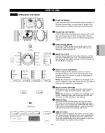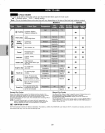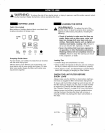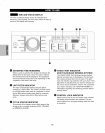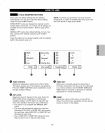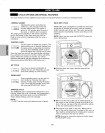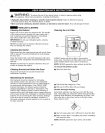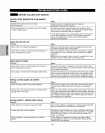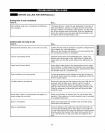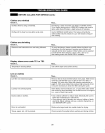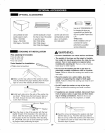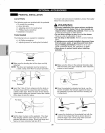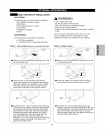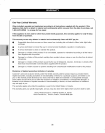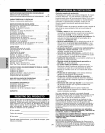
I I
BEFORE CALLING FOR SERVICE(cont.)
Drying time is not consistent
Check if...
Then...
Heat settings, load size, or dampness of clothing is
not consistent.
The drying time for a load will vary depending on the type of
heat used (electric, natural, or LP gas), the size of the load,
the type of fabrics, the wetness of the clothes, and the condi-
tion of the exhaust ducts and lint filter. Even an unbalanced
load in the washer can cause poor spinning resulting in wet-
ter clothes which will take longer to dry.
Clothes take too long to dry
Check if...
Exhaust ducts blocked, dirty, or duct run is too long.
Load is not properly sorted.
Large load of heavy fabrics.
Dryer controls are not set properly.
Lint filter needs to be cleaned.
House fuse is blown, circuit breaker has tripped, or
power outage has occurred.
Then...
Confirm that the exhaust ductwork is properly configured and
free of debris, lint, and obstructions.
Make sure that outside wall dampers can open properly and
are not blocked, jammed, or damaged.
Separate heavy items from lightweight items. Larger and
heavier items take longer to dry. Light items in a load with
heavy items can fool the sensor because the light items dry
faster.
Heavy fabrics take longer to dry because they tend to retain
more moisture. To help reduce and maintain more consistent
drying times for large and heavy fabrics, separate these items
into smaller loads of a consistent size.
Use the appropriate control settings for the type of load you
are drying. Some loads may require an adjustment of the dry
level for proper drying.
Remove the lint from the filter before every load. With the lint
removed, hold the filter up to a light to see if it is dirty or
clogged. If it looks dirty, follow the cleaning instructions on
page 25. With some loads that produce high amounts of lint,
it may be necessary to pause the cycle and clean the filter
during the cycle.
Reset circuit breaker or replace fuse. Do not increase fuse
capacity. If the problem is a circuit overload, have it corrected
by a qualified electrician.
Dryer is overloaded. Divide extra large loads into smaller loads for better drying
performance and efficiency.
Dryer is underloaded.
if you are drying a very small load, add a few extra items to
ensure proper tumbling action. If the load is very small and
you are using Sensor Dry cycles the electronic control cannot
properly sense the dryness of the load and may shut off too
soon. Use timed dry or add some extra wet clothes to the
load.
27
I I



